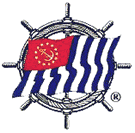Click
the answers that you think are correct — see how your
knowledge stacks up!
1. A float plan includes a description of your boat, who is on board,
your safety equipment, and, most importantly:
2. Steering a PWC involves turning a movable nozzle that directs a high-
pressure stream of water either right or left,turning the boat in
either direction. It is important to know that a PWC will turn only
when the:
3. A PWC lanyard cut-off-switch when fastened to your wrist will:
4. When operating a PWC near shore, launch areas, swimming areas,
docks, and anchored boats:
5. Which of the following sentences relative to trailer tongue weight
on a hitch coupler ball is TRUE?
6. One of the most reliable sources of up-to-date weather is:
7. It is important that life preservers used in active water sports
have:
8. Most boating accidents occur in small open boats on small inland
bodies of water:
9. Knowledge of current weather conditions is important when
navigating the ICW because there is little room for maneuvering and:
10. In the U.S. Aids to Navigation System, identifying numbers on
navigation marks will always _______________ when you return from sea.
11. Because the Coast Guard recognizes personal watercraft as
full-fledged boats:
12. Ocean levels, with a few exceptions:
13. Towboats are not able to stop or turn easily. In addition, they are
often unable to:
14. A primary charachteristic of Great Lakes weather is:
15. Federal regulations require the following equipment on a personal
watercraft: a fire extinguisher, a sound-producing device, and a:
16. Your boat has a yellow hull. After registering it with the state and
receiving a boat number, you purchase:
17. If you are hailed by a law enforcement vessel, you should:
18. In The Navigation Rules, the General Rule of Responsibility states
that nothing in The Rules will exonerate any boater from consequences
of neglect in complying with The Rules, or in taking any precaution
needed to avoid collision. This means that:
19. Coast Guard boating safety statistics show that alcohol involvement
in reported accidents accounted for _______ percent of all boating
fatalities.
20. Coast Guard boating safety statistics indicate that ________ percent
of all boating deaths took place on boats whose operators had not
completed a boating course.

